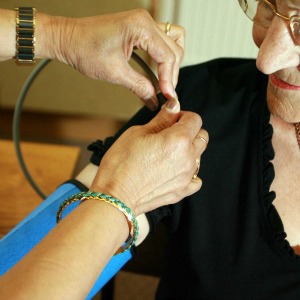Researchers urge NICE to lower blood pressure targets for high-risk patients

Patients at high risk of cardiovascular disease could benefit from having their blood pressure more tightly controlled than is currently recommended in NICE guidelines, a new meta-analysis has found.
The study – published in The Lancet – concluded that more intensive treatment of these patients to get their blood pressure levels down below the current target of 140/90mmHg resulted in ‘large’ reductions in their risks of heart attacks and strokes.
The study’s authors said NICE guidelines – which recently relaxed blood pressure targets for high-risk groups from 135/85 to 140/90mmHg – should be revised to bring back a lower target.
The meta-analysis of the latest evidence took in 19 trials of intensive versus standard blood pressure-lowering treatment, including a total of nearly 45,000 participants.
Those treated intensively achieved an average blood pressure of 133/76mmHg, compared with 140/81mmHg in those treated with a standard regimen.
Over four years of follow-up, the intensive treatment patients had a 13% lower relative rate of MI and a 22% lower relative risk of stroke than the standard treatment group.
The researchers said benefits were seen from additional blood pressure lowering below 140/90 mmHg across all patient groups, but that the ‘absolute benefits were greatest in trials in which patients had vascular disease, renal disease or diabetes’.
In these trials, they calculated that the number needed to treat to avoid a major vascular event was 94, compared with 186 in other groups of patients.
The more intensive treatment regimen was linked to a roughly three-fold increased risk of hypotension, but the researchers said ‘there was no suggestion that these adverse effects would outweigh the benefits of treatment in high-risk patient populations’.
They concluded that ‘the net absolute benefits of intensive blood pressure lowering in high-risk patients are large’ and that ‘existing clinical guidelines should be revised accordingly, to recommend more intensive blood pressure-lowering treatment in high-risk patient groups’.
Lead author Professor Anthony Rodgers, professor of global health at the George Institute of Global Health in Sydney, Australia, said: ‘Our robust evidence clearly shows that treating blood pressure to a lower level than currently recommended targets results in better health outcomes for patients.’
The call comes after US researchers released preliminary findings from a large study that they say showed clear benefits from lowering blood pressure below 140/90mmHg in high-risk patients, while experts previously called for revision of the blood pressure targets for patients with diabetes specifically.
A NICE spokesperson said the 2011 hypertension guidance was ’due to be checked shortly to see if it needs updating’ and that ’in order to inform that decision we’ll look at all the relevant evidence… that has become available since the guideline was published, as well as asking healthcare professionals and patients for their views’.
Lancet 2015; available online 6 November
Visit Pulse Reference for details on 140 symptoms, including easily searchable symptoms and categories, offering you a free platform to check symptoms and receive potential diagnoses during consultations.









